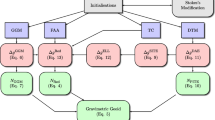Abstract
One of the problems in the single-objective optimisation models (SOOMs) for optimising geodetic networks is the contradiction of the controlling constraints, which may lead to their violation or infeasibility in the optimisation process. One way to solve this problem is to use a bi-objective optimisation model (BOOM) instead of SOOMs. In this paper, we will use the BOOM of precision and reliability and investigate the influence of the controlling constraints in a two-dimensional simulated network. Our studies show that the unconstrained BOOM is a good model, which almost fulfils our precision and reliability demands of the network. This model is also economical as more observables are removed from the plan whilst adding the controlling constraints leads to including more observables, which have no significant role.


Similar content being viewed by others
References
Alzubaidy RZ, Mahdi HA, Hanooka HS (2012) Optimized zero and first order design of micro geodetic networks. J Eng 18(12):1344–1364
Amiri-Seemkooei A (1998) Analytical methods in optimization and design of geodetic networks. K. N. Toosi University of Technology, Surveying Engineering, Tehran
Amiri-Seemkooei A (2001a) Comparison of reliability and geometrical strength criteria in geodetic networks. J Geod 75(4):227–233
Amiri-Seemkooei A (2001b) Strategy for designing geodetic network with high reliability and geometrical strength criteria. J Surv Eng 127(3):104–117
Amiri-Seemkooei A (2004) A new method for second-order design of geodetic networks: aiming at highreliability. Surv Rev 37(293):552–560
Amiri-Seemkooei A (2008) Analytical first-order design of geodetic networks. Iran J Eng Sci 1(1):1–12
Amiri-Seemkooei A, Asgari J, Zangeneh-Nejad F, Zaminpardaz S (2012) Basic concepts of optimization and design of geodetic networks. J Surv Eng 138(4):172–183
Bagherbandi Mohammad, Eshagh Mehdi, Sjöberg Lars Erik (2009) Multi-objective versus single-objective models in geodetic network optimization. Nordic J Surv Real Estate Res 6(1):7–20
Bazaraa MS (1974) Quadratic set covering problem. Georgia Institute of Technology, Atlanta
Bazaraa MS, Shetty CM (1979) Nonlinear programming. Wiley, New York
Berne JL, Baselga S (2004) First-order design of geodetic networks using the simulated annealing method. J Geod 78:47–54
Blewitt G (2000) Geodetic network optimization for geophysical parameters. Geophys Res Lett 22(27): 2615–3618
Doma MIA (2013) Particle swarm optimization in comparison with classical optimization for GPS network design. J Geod Sci 3(4):250–257
Doma MIA (2014) A comparison of two different measures of precision into geodetic deformation monitoring networks. Arab J Sci Eng 39:695–704
Eshagh M (2005) Optimization and design of geodetic networks. Islamic Azad University, Shahr-e-Rey branch, Tehran
Eshagh M, Kiamehr R (2007) A strategy for optimum designing of the geodetic networks from the cost, reliability and precision views. Acta Geodaetica et Geophysica Hungarica 42(3):297–308
Gerasimenko MD, Shestakov NV, Kato T (2000) On optimal geodetic network design for fault-mechanics studies. Earth Planets Space 52:985–987
Grafarend EW (1975) Second order design of geodetic nets. Zeitschrift für Vermessungswesen 100:158–168
Khatri CG, Rao CR (1968) Solutions to some functional equations and their applications to characterization of probability distributions. Sankhya 30:167–180
Koch KR (1982) Optimization of the configuration of geodetic networks. Deutsche Geodaetische Kommission 3(258):82–89
Koch Karl Rudolf (1985) First order design: optimization of the configuration of a network by introducing small position changes. In: Grafarend EW, Sanso F (eds) Optimization and design of geodetic networks. Springer, Berlin, pp 56–73
Kuang S (1991) Optimization and design of deformation monitoring schemes. PhD thesis, Department of Surveying Engineering, University of New Brunswick, Fredericton, Canada
Kuang S (1993) Second order design: shooting for maximum reliability. J Surv Eng 119(3):102–110
Kuang S (1996) Geodetic network analysis and optimal design: concepts and applications. Ann Arbor Press, Chelsea
Lemke CE (1962) A method of solution for quadratic programs. Manag Sci 8(4):442–453
Mehrabi H (2002) Fully-analytical approach to bi-objective optimization and design of geodetic networks. Master Thesis, Geodesy and Geomatics, K. N. Toosi Technical University, Tehran
Mehrabi H, Voosoghi B (2014) Analytical method in selecting optimal observational plan of local GPS networks. J Geod Sci 4(1):87–97
Peiliang X (1989) On robust estimation with correlated observations. Bull géod 63(3):237–252
Schmitt G (1980) Second order design of free distance networks considering different types of criterion matrices. Bull Geod 54:531–543
Schmitt G (1985) Second order design. In: Grafarend EW, Sanso F (eds) Optimization and design of geodetic networks. Springer, Berlin, pp 74–121
Schmitt G (1985) Third order design. In: Grafarend EW, Sanso F (eds) Optimization and design of geodetic networks. Springer, Berlin, pp 122–131
Smith Alan A, Hinton Ernest, Lewis Roland W (1983) Civil engineering systems analysis and design. Wiley, New York
Teunissen P (1985) Zero order design: generalized inverses, adjustment, the datum problem and S-transformations. In: Optimization and design of geodetic networks, Springer, Berlin, Heidelberg, pp 11–55
Yetki M, Cevat I, Yigit CO (2008) Optimal Design of Deformation Monitoring Networks using PSO Algorithm. In: 13th FIG symposium on deformation measurement and analysis, 4th IAG symposium on geodesy and geotechnical and structural engineering, 12–15 May 2008
Acknowledgments
The authors would like to thank FORMAS for granting Project DNR-245-2012-356 and Professor Lars E. Sjöberg at Royal Institute of Technology (KTH) in Sweden.
Author information
Authors and Affiliations
Corresponding author
Rights and permissions
About this article
Cite this article
Eshagh, M., Alizadeh-Khameneh, M.A. The effect of constraints on bi-objective optimisation of geodetic networks. Acta Geod Geophys 50, 449–459 (2015). https://doi.org/10.1007/s40328-014-0085-1
Received:
Accepted:
Published:
Issue Date:
DOI: https://doi.org/10.1007/s40328-014-0085-1




